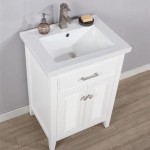What Adhesive To Use To Attach Sink To Vanity
When it comes to attaching a sink to a vanity, the type of adhesive you use is crucial for ensuring a secure and long-lasting bond. Choosing the right adhesive depends on several factors, including the materials of the sink and vanity, the weight of the sink, and the desired level of water resistance.
Types of Adhesives
1. Silicone Caulk: - Silicone caulk is a popular choice for attaching sinks to vanities due to its flexibility, durability, and water resistance. - It is easy to apply and can accommodate movement between the sink and vanity, preventing cracking or breaking of the seal.
2. Epoxy: - Epoxy is a two-part adhesive that creates a strong, permanent bond. - It is ideal for heavy sinks or those made of materials that are difficult to bond with other adhesives, such as cast iron or stone.
3. Construction Adhesive: - Construction adhesive is a versatile adhesive suitable for bonding a wide range of materials, including wood, metal, and plastic. - It offers good strength and durability, making it a practical choice for most sink installations.
4. Liquid Nails: - Liquid Nails is a type of construction adhesive specifically designed for heavy-duty applications. - It is known for its high strength and water resistance, making it suitable for attaching heavy sinks, such as those made of granite or marble.
Choosing the Right Adhesive
- Sink Material: Non-porous sinks, such as ceramic or vitreous china, require an adhesive that can bond well to glazed surfaces. For porous sinks, such as stone or concrete, an adhesive with good penetration is recommended.
- Vanity Material: The material of the vanity also affects adhesive selection. For wooden vanities, a construction adhesive or Liquid Nails is suitable. For metal or laminate vanities, silicone caulk or epoxy may be more appropriate.
- Sink Weight: Heavier sinks require a stronger adhesive, such as epoxy or Liquid Nails. Lighter sinks can be attached with silicone caulk or construction adhesive.
- Water Resistance: If the sink will be exposed to frequent water, an adhesive with good water resistance, such as silicone caulk or Liquid Nails, is essential.
Application Instructions
- Clean and dry the surfaces of the sink and vanity.
- Apply the adhesive according to the manufacturer's instructions, typically using a bead around the perimeter of the sink.
- Position the sink on the vanity and press down firmly to ensure good contact.
- Use clamps or heavy objects to hold the sink in place while the adhesive cures. Allow ample time for the adhesive to set before using the sink.
By selecting the appropriate adhesive and following the application instructions carefully, you can ensure a secure and durable bond between the sink and vanity.

Easy Ways To Install A Vanity Top With Pictures Wikihow

What Adhesive Should You Use To Attach A Sink Vanity Angi

How To Install A Bathroom Vanity

How To Re Attach Sink A Vanity Diy Home Improvement Forum
What Adhesive To Use Attach Sink Vanity Sticky Aide

Tips And Tricks To Installing A Bath Vanity Countertop

Easy Ways To Install A Vanity Top With Pictures Wikihow

How To Install A Pedestal Sink Elevate Your Bathroom

How To Install A Backsplash On Vanity Bowed Wall

Pros Cons Of A Vessel Sink







